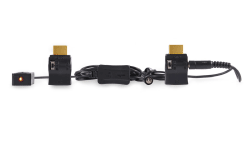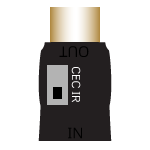IR Passback: The Basics
Definition
When you push a button on one of your remote controls at home, a short burst of infrared light is emitted from it (normally from the top at the front of the remote). This short burst of light contains information about the button you have pushed. When this light reaches your source device (sky box, Apple TV etc) it is interpreted and the function of the button you have pushed (stop, play, pause etc) will be performed.
This type of control is “line of sight”. You have to point your remote control at the item you want to control (normally a source device like a sky box). It cannot pass through cupboard doors, through walls etc.
When your source device isn’t in “line of sight” you can use an IR passback system to take the bursts of light from your remote control from one place to another.
This passback of control is normally from where you sit to watch TV, to where the device you want to control is kept.
It’s called passback, because remote control commands are passed back to the device you want to control. A basic system has three parts, something to receive the bursts of light and interpret them, something to then repeat the burst of light out in front of the device to be controlled and the thing in the middle that connects these two.
For example, our IR over HDMI kits contain an infrared receiver, an infrared transmitter and they use a HDMI lead to connect the two.

Types of passback
Blasting IR
IR blasting is where an infrared transmitter is positioned in front of a device (or devices) to be controlled and simply repeats out every burst of light sent to it. Typically, multiple devices are controlled by one infrared transmitter. It can also refer to a situation where multiple IR transmitters, all plugged into the same IR passback device (a HDMI matrix for example) emit the same codes as each other at the same time.
Discrete IR
Discrete IR refers to a particular situation where multiple IR transmitters are connected to a HDMI matrix, but each transmitter is numbered. The numbers will correspond to the inputs on the matrix and each transmitter is placed in front of the source device plugged into the same numbered input. i.e. IR transmitter one is placed in front of the device plugged into input port 1 on the matrix. The IR control commands from each of the displays plugged into the matrix are then routable. This means that if TV 1 is watching input 1, IR transmitter 1 will be emitting the codes coming back from TV1. If TV 2 is watching input 2, IR transmitter 1 will not be emitting the codes coming back from TV2. What this means in practice is that you can have two identical devices plugged into a matrix, such as two sky boxes, the channel will not be changed on both boxes at once. You only have control over the device you are watching. So you can only change the channel on the sky box you are watching. With blasting IR, both sky boxes would have their channels changed.
Basic setup information
The Transmitter (TX)

The IR transmitter is placed in front of the device or devices you want to control. If you are controlling multiple devices with one IR transmitter, then it needs to be placed so that the emitted burst of light is in line of sight of all of the devices. If you are using an IR transmitter to control just one device, then it needs to be placed near to the device and in front of the “IR window”. Every device will have its IR receiver in a different position. Sometimes they are identified in your device manual or by a logo on the front of the device. Sometimes they are hidden or identifiable by a thinning of plastic (literally a window for the IR to get in) on the front of the device. Shining a torch along the front of a device can help spot its location. For example, new sky HD boxes have their IR receiver dead in the middle of the front of the box. Older sky HD boxes have theirs roughly two inches to the right of centre if you are looking at the front of the box.
The Reciver (RX)

The Receiver is placed somewhere in line of sight of where you sit to watch TV. Usually attached to the side of your TV because that’s where you naturally point your remote controls.
The Dongle

You will receive a dongle with our IR over HDMI kits and our HDMI Matrices with IR passback. Dongles are either plugged in-between the HDMI port and HDMI cable on the rear of your source device or rear of your TV in the HDMI socket that you. Which will depend on the product you have. The switch on the top dongle should always be set to “IR” NOT “CEC”.
TV settings
When using a HDMI device with IR passback, the CEC feature on your TV needs to be switch off. This can be called one of many things by different manufacturers. Samsung call it Anynet, Panasonic call it Vieralink and Sony call is Bravialink. You will need to refer to your source and TV manuals to find the setting.
Remote
It is always worth having fresh batteries or fully charging remotes when using them over an IR passback system. Repeating the signal over long distances sometimes needs a more powerful burst of light than a set of flat batteries will give out of a remote control. From our experience, this affects Sky remote controls the most.